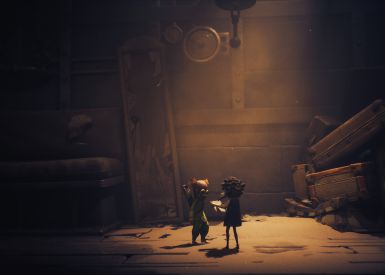Our feature on the flawed work of art that is The Legend of Zelda: Majora's Mask continues. See Part I here.
The Narrative Undermines the Gameplay in The Legend of Zelda: Majora's Mask
In The Legend of Zelda: Majora's Mask, as you probably well know, Link, the Hero of Time, is trapped in the world of Termina, which will be destroyed by a falling Moon three days after the game starts. Link can't save the world in so little time, so with the help of the Ocarina of Time, he repeats those same three days over and over again until he can save Termina.

Let's start where the starting's good: the beginning of the game, the first three day cycle. The game begins when Link arrives in the world of Termina and the Skull Kid, a forest spirit controlled by the evil Majora's Mask, steals the Ocarina of Time. The Skull Kid transforms Link into the treelike Deku Scrub. Link has three days to recover the Ocarina of Time before the Moon destroys Termina and Link with it.
In terms of story, the first cycle is very well told, especially if you're coming into the game blind and don't know the game's core mechanic. Link is thrown, in his wooden, childlike Deku form, into Clock Town with no guidance at all. And he has three days to figure out where the Skull Kid is, and how to get back the Ocarina.
It's the closest the Zelda series ever gets to a sandbox world.

So Link has around 72 hours to talk to the villagers, get a sense of the living world of the village, and join their visceral fear of the descending moon. Link's discovery that the Skull Kid himself, possessed by the demonic mask, is responsible for the falling Moon adds responsibility to his urgency: Link caused the Skull Kid to go to Termina in the first place. And when Link finally confronts the Skull Kid, minutes before the Moon destroys Termina, and takes back the Ocarina of Time, it's truly terrifying: Link and the world are mere moments from death, and it seems like there's no way out.
The end of the first three-day cycle is probably the strongest part of the narrative in Majora's Mask. When he gets the Ocarina of Time back, and realizes that he still can't defeat the Skull Kid, Link plays the Song of Time -- and finds himself transported back to the beginning of his first day in Termina. The Moon hangs high in the sky again, all the townspeople who fled in fear are back, and his true quest -- to defeat the Skull Kid and recover Majora's Mask -- is ready to begin.
But there's a problem.
The first three-day cycle tells a fantastic story and sets the mood for the entire game, quite successfully. But it's absolutely miserable to actually play. Link in Deku Form has few abilities, and in Clock Town he can't use his weapons -- and in Deku form, Link can't leave Clock Town. So the entire first three days (about an hour in real time) not only denies Link his trademark sword and shield, but any weapons at all.
All Link can do in the first three-day cycle is talk to townspeople and solve the two or three puzzles that open the way to the Skull Kid. Those puzzles are basically tutorials; they teach the player how to move around and encourage Link to talk to everyone. They aren't particularly interesting. And in between solving them, Link has nothing to do except explore the town and wait for the story to advance. For an hour.
Majora's Mask, as a Zelda game, doesn't even really start until the second three-day cycle, when Link is back in human form and given the freedom to venture outside freely. The game spends so much time setting up atmosphere at the beginning that it forgets to actually be a game until later on. It's worth it, but it's the slowest start a Zelda game had seen up to that point.
Those first three days are telling. They establish a game whose mechanics and story are at odds with each other from beginning to end.
Continue reading:
Majora's Mask Part III: How the Gameplay Undermines the Narrative
Majora's Mask Part IV: The Gameplay and the Narrative in Harmony
















